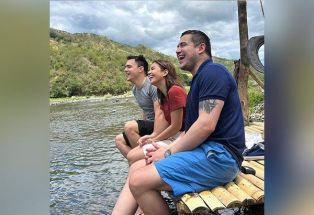Top 5 Pinoy soap operas of 2015
MANILA, Philippines — 2015 has been a year of innovations, as far as the “teleserye” is concerned.
The rise of the “Kalyeserye” through Eat Bulaga’s AlDub fame proves that the genre continues to evolve, its power extending to other equally institutional genres like the variety or noontime show.
The Filipino audience’s passion for narrative and romance propels the evolution, especially that the teleserye concept marked its 15th year, has been in extensive usage in formal and informal discourses to refer to the Filipino soap opera, and has basically transcended its initial network-based, marketing aim.
RELATED: Top 6 Pinoy TV moments of the year
This year’s harvest, so to speak, proves that both the word and the local genre have come of age because of the industry's exciting ventures and treatments, even if the networks were reworking old material.
Two reworkings highlighted this year, both canonicals in their own ways, but approached differently to articulate distinctions.
ABS-CBN’s Pangako Sa ‘Yo, was the banner remake, not only because it marked the 15th year of the teleserye concept but also reinvented the original by catching up with the times. Now on its “book two”—because the expositional “first book” has ended with the fall of the Buenavista political clan and the supposed death of the nemesis Madame Claudia Buenavista in a car crash—the soap has so far provided interesting characterization for the key characters, but more of this later.
On the other end of the spectrum is GMA 7’s Marimar, which I think distinguished itself for the campy acting and quotable lines of Jacklyn Jose, who played the unforgettable Señora Angelica Santibañez. The soap was of course appealing because of the Tom Rodriguez-Megan Young tandem, but it was the antics of Jose’s Angelica that carried the show. We needed a break from all the heaviness that teleseryes tend to offer, which may also be found in political news and current affairs that emulate teleseryes. This year’s Marimar did not make the cut because, as in the first one, it was merely a parody of the original, albeit with more finesse.
This year may also be described as a year of teleserye romance, and one might ask: what year is not a year of romance for the teleserye? I say that it is a year for romance because of the teleserye pairs that emerged and gathered strong following. (This list does not include Eat Bulaga’s “Kalyeserye” because it is sui generis, of its own kind, and worthy of a separate and devoted explication).
There was also a remarkable sense of place in some of the Pinoy soap operas produced in 2015. The ABS-CBN soap Forevermore, which aired from late 2014 to 2015, showed a new sense of Baguio City through its famous La Presa mountainside community. The city provided a quaint backdrop for the blossoming of the romance between the characters of Enrique Gil and Liza Soberano. The teleserye had more character because of its location, which became more believable with the characters’ conscious use of Ilocano.
Meanwhile, GMA’s Dangwa is notable for its foray into the urban landscape, which basically shaped the lives of people Rosa (played by Janine Gutierrez) met in the course of her journey.
All things considered, I offer you my take of this year’s notable teleseryes:
5. The Rich Man’s Daughter

Like Destiny Rose, this GMA primetime soap opera provided space for the underrepresented lesbian figure in Philippine society by dramatizing one woman’s awakening into her sexuality. The rich man’s daughter was Jade, played by Rhian Ramos. Jade came from a conservative Filipino-Chinese family and was in a relationship with David, played by Luis Alandy, for many years. The equilibrium changed after she met the wedding coordinator Althea, played by Glaiza de Castro. They developed fondness for each other which evolved into romance that complicated the situation and compelled Jade’s father to offer a million pesos to any man who could bring her back to her “normal” self. The ending kiss between the two women in the finale was significant: it used as a backdrop what seemed like the LGBT Pride March. I say that it’s bolder than My Husband’s Lover; by situating its last moments in the scene of the march, it has put its foot down—in stilettos, mind you—to politicize the drama of the underrepresented.
4. Pangako Sa ‘Yo

Hands down, this teleserye is the year’s banner remake, and it has to be commended for the way it distinguished itself from the first Pangako Sa ‘Yo. The team already has the production structure so to speak, as well as the familiarity of the audience. When its first book ended however, it reinvented the story and helped Daniel Padilla emerge into a more mature actor. Finally, he had been given a chance to dramatize pathos that added to his character more spunk and motivation. The currently running second book of the teleserye where the main characters are slowly coming together again provided a breather to the intense tragic last scenes of the first book. Pangako Sa ‘Yo 2015 is the monument to the teleserye concept and it has certainly come a long way from its original form. This time, it banked on very effective psychological treatment to thresh out character motivations and development.
3. On The Wings of Love

This teleserye is a breakthrough of the year and a refreshing one, perhaps because of the many interesting perspectives brought in by directors Jojo Saguin and the emerging Antoinette Jadaone. Jadaone took on this soap fresh from her success in the film That Thing Called Tadhana, and her directorial gloss is certainly seen in this transnational romance featuring the characters of Reid and Lustre, the lovers Clark and Leah. Yes, On The Wings of Love is another American dream drama, and its story certainly revolved around the challenges and dreams of the diasporic Filipino. It has been showing different facets of this collective desire for mobility, as it has also been dramatizing the interesting archipelagic variousness of Filipino culture, basically shaped by this neocolonial dream. We hear Nanette Inventor’s signature Kapampangan on the one hand, and all of a sudden, we are transported by the whole gang to Ilocos Norte, which lets us hear the Ilocano lilt and verve, as Leah retraces the roots of her mother, who abandoned her family many years ago. Notable as well was its inclusion of spoken word poetry, courtesy of Juan Miguel Severo, whose words add more nuance to the “hugot” and “kilig” of the teleserye, making it not only fun but intelligent.
2. Oh My G!

Speaking of intelligence, this well-thought, tightly structured teleserye offered a very refined treatment of one’s youthful search for God in days of desolation. Reportedly produced in line with the 500th anniversary of the writer and mystic St. Teresa of Avila, the teleserye used the figure of the Carmelite saint as an important motif, tying the loose ends of the narrative and helping the lead Janella Salvador’s character Sophie piece together her father’s dying wish—that of looking for a certain Anne Reyes, who happens to be her sister, and who she discovered to have taken the habit of a Carmelite contemplative nun. Sophie, a digitally savvy and social media creature, embarked on this adventure, typifying the contemporary teenager looking for herself amidst life’s early tragedies. She was accompanied by the omnipresent G, God himself, who took on different human forms but mostly inhabited the figure in all white played by Leo Rialp. G made sure she did not stray from her mission. Sophie’s contemporaneous language and consciousness proved to be one of this year’s best in characterization. Also, the insertion of Filipino poetry in the classroom scenes was very commendable and educational.
1. Bridges of Love

Another intelligently conceptualized teleserye was this action-packed sibling rivalry and love triangle story spanning two generations and brought together by a controversial bridge project marred by corruption. The stowaway siblings Gael and JR, played well by Jericho Rosales and Paolo Avelino, respectively, were separated from each other by the tragic collapse of the aforementioned bridge. Later in life, they were brought together by a woman, named Mia, played by Maja Salvador. Mia was Gael’s girlfriend before he flew to the Middle East to work, but only to land in jail. After his travails, he returned to the Philippines as a new man, achieving his dream to become an architect, and internationally renowned at that. Mia became entangled with Carlos Antonio, who was actually JR, kept and raised by the construction magnate Lorenzo Antonio. Lorenzo married Alexa, played by Carmina Villaroel, who also had a previous affair with Carlos. Old conflicts abound in this story since Lorenzo was in the past involved with Gael and JR’s mother, Marilen, played by the returning Maureen Mauricio. He continued bearing the grudge against Marilen and her husband Manuel, played by Lito Pimentel. This grudge was revealed to be the motivation for saving JR and raising him as Carlos Antonio. As the most intense teleserye of the year, Bridges of Love boasted of a powerhouse cast that never faltered in acting vigorously. It also featured a satisfying, almost Oedipal, bloody climax that is certainly one for the books.
- Latest
- Trending




























